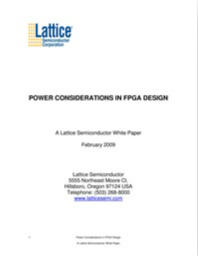POWER CONSIDERATIONS IN FPGA DESIGN
Power has always been a design consideration. Traditionally, though, a lower priority has been assigned to power than to most other variables (speed/performance, cost, time-to-market, risk, etc.). In today's marketplace, however, power has become a very important component in the designer's decision making process. There is good reason for this. Power translates to significant system cost.
Download this whitepaper to learn more.
Read More
By submitting this form you agree to Lattice Semiconductor Corporation contacting you with marketing-related emails or by telephone. You may unsubscribe at any time. Lattice Semiconductor Corporation web sites and communications are subject to their Privacy Notice.
By requesting this resource you agree to our terms of use. All data is protected by our Privacy Notice. If you have any further questions please email dataprotection@techpublishhub.com
Related Categories: Analog, Components, cooling, Evaluation boards, Power, Switches

More resources from Lattice Semiconductor Corporation
LOW COST BOARD LAYOUT TECHNIQUES FOR DESIGNING WITH PLDS IN BGA PACKAGES
Programmable logic devices (PLDs) offer inherent time-to-market and design flexibility advantages over application specific integrated circuits (AS...
ispMACH® 4000ZE - Enabling CPLDs in Ultra High Volume, Low Power Applications
Design engineers are constantly challenged to develop new products with improved features and functionality over previous generation and competitiv...
1:2 and 1:1 MIPI DSI Display Interface Bridge Soft IP
As the industry evolves, bandwidth requirements have exceeded what display manufacturers are capable of manufacturing, while application processor ...
